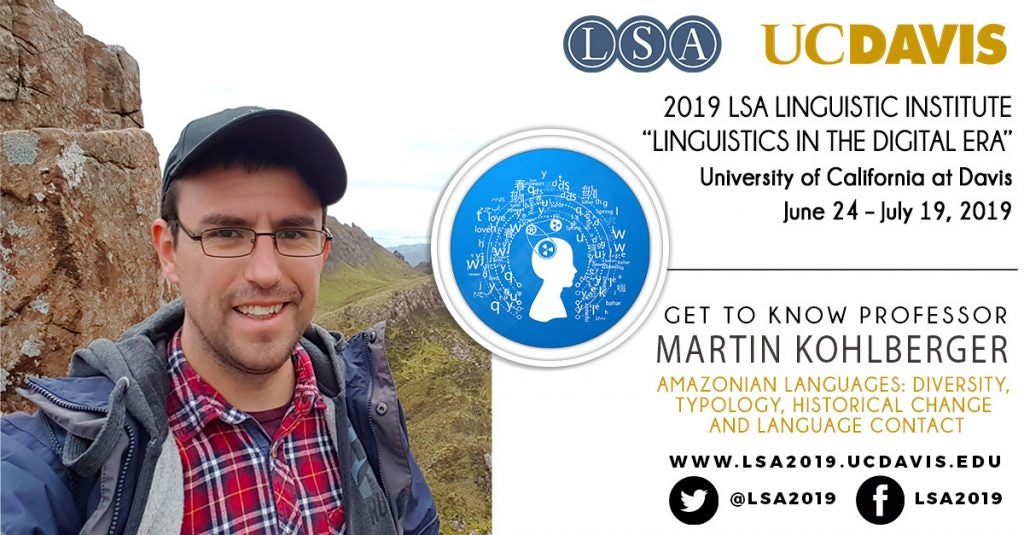
Martin Kohlberger will be co-teaching a course called “Amazonian Languages: Diversity, Typology, Historical Change and Language Contact” with Katherine Bolaños at the 2019 Institute. The course is a comprehensive introduction to languages spoken in the Amazon basin and the features that make them so engaging. Continue reading to learn about Martin’s research and linguistic background as well as his fascination with coins and banknotes.
1. Can you please tell us about your linguistic background?
I grew up in a trilingual family in Ecuador speaking Spanish, English and German. I think this probably helped spark my interest in languages and linguistics from early on. When I was 18, I moved to Scotland to do my undergraduate degree in Linguistics at the University of Edinburgh. For my honours project, I decided to work on the phonetics and phonology one of the indigenous languages spoken in Ecuador, Central Highland Ecuadorean Kichwa (a northern Quechuan language). After that, I decided I really wanted to continue doing fieldwork in Ecuador with indigenous communities, so in 2011 I started a PhD position at Leiden University in the Netherlands with the goal of documenting and analysing the grammar of Shiwiar, a Chicham language spoken in the Amazonian lowlands of eastern Ecuador and northern Peru. I am now finishing my PhD and starting a new project at the University of Texas at Austin to document and analyse the Kamsá language, an isolate in southern Colombia.
2. When did you first join the LSA?
I joined the LSA in 2011, the year I started my PhD programme. I attended the 2011 LSA Institute in Boulder, and I have been to the LSA annual meetings in Minneapolis, Washington DC, Austin and Salt Lake City.
3. Can you tell us about the course you are teaching at the Institute?
The course I will be co-teaching with Katherine Bolaños at the 2019 Institute is a comprehensive introduction to languages spoken in the Amazon basin and the characteristics that make them so fascinating. The Amazon region of South America is one of the most linguistically diverse corners of the world, but it is also an area that has historically only been scarcely studied. The course will be divided up into four components. First we will look at an overview of the languages that are spoken in the region and what their historical and current relationships are. Then we will look into the grammatical traits that are commonly found in the Amazon, and in what ways Amazonian languages have helped expand our understanding of linguistic typology. After that we will look at how the languages have developed over time, and what can be said about historical processes of change in the Amazon basin. Finally, we will look at the intricate language contact situations that are found in the region, and what effects these have had on the structure of Amazonian languages.
4. What research are you currently working on?
I am currently finishing a descriptive grammar of Shiwiar, the Ecuadorean indigenous language that I worked on for most of my PhD. Writing a grammar has been an exciting enterprise because it has allowed me to explore very different areas of language structure. I am also now beginning a new documentary project to work on Kamsá, a language isolate spoken in a single valley in the Andean foothills of southern Colombia.
5. What is your favorite hobby or pastime?
By far my favourite hobby is spending time in nature, hiking and camping. I also love taking spontaneous road trips to places of natural beauty. There’s something very exciting about getting in the car and driving off to an unplanned hiking trip.
My secret guilty-pleasure hobby – although this is possibly my worst kept secret – is that I’m an obsessive coin and banknote collector. If you work in the same linguistics department as me it won’t be long before I start asking you if you happen to have leftover change from trips abroad that I can exchange from you.
6. In a parallel universe in which you are not an academic/linguist, what would you be?
I would definitely be a tour guide. I am actually already a certified historical tour guide for Scotland, and on many weekends you will find me as a tour guide in places like Edinburgh Castle or the Scottish Highlands. It’s the perfect job: you get paid to go on amazing roadtrips to beautiful places!
7. What are you most looking forward to about Davis?
I’m excited to explore northern California during weekends and before and after the Institute. I lived in Santa Barbara for two years, so I’ve done a lot of hiking in the southern half of the state, but northern California will be new for me.
8. Ice cream or Cake? Cats or Dogs? Quarter system or Semester system?
Cake! Actually, sticking toffee pudding, which if you haven’t had it is only the best dessert in the world, and it combines date cake covered with hot toffee sauce with vanilla ice cream. Best of all words.
Dogs! I like cats a lot too, but I desperately want a dog. One that will go hiking in the Scottish Highlands with me.
I don’t have a preference for quarters or semesters. Either!
9. What advice would you give to graduate students interested in pursuing a career in linguistics?
Take it easy on yourself! I had a lot of ups and downs during my graduate years, and although I really love linguistics there were many moments when I felt overwhelmed with stress and terrified by my ever-growing to-do list. In the end, the key was to give myself a little bit more time when I felt like I needed it, and to take a short break when things got too hectic. And keep your colleagues in the loop; people will understand.
